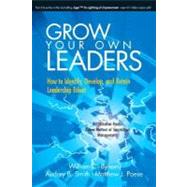
Note: Supplemental materials are not guaranteed with Rental or Used book purchases.
Purchase Benefits
What is included with this book?
WILLIAM C. BYHAM, Ph.D. is Chairman and CEO of Development Dimensions International (DDI), a leading-edge Human Resources consultancy that specializes in the identification and development of leadership talent. He co-founded DDI in 1970, and has worked with hundreds of the world's largest organizations relative to executive assessment, executive development, and succession management. His work on executive succession has been featured in Fortune, the Los Angeles Times, and many other leading publications.
Byham is co-author of Zapp! The Lightning of Empowerment, a groundbreaking book on empowerment that has sold more than 4.5 million copies since its 1988 publication. He has co-authored 18 other books, including seminal books on the assessment center method, which established the effectiveness of assessment centers as a method of executive selection and development-needs diagnosis. His best-selling business book HeroZ—Empower Yourself, Your Co-Workers, and Your Company offers step-by-step techniques for making meaningful decisions, measuring progress, and working effectively in teams.
AUDREY B. SMITH, Ph.D. is consulting vice president of the Staffing and Assessment Consulting group and Executive Succession Management group at DDI. In this role, she directs the activities of consulting teams that deliver executive development and succession management consulting services and leadership assessment center technology. Her work has focused on the design, implementation, and validation of Acceleration Pool systems; selection systems, including executive team reengineering applications; development assessment; and executive coaching. She has worked with many clients throughout the world, including General Motors, Northern Telecom, BMW, PPG Industries, the U.S. Postal Service, Steelcase, Whirlpool, the United Nations, United Airlines, Toyota, and Unisys Corporation. Before joining DDI, Dr. Smith worked for Rockwell International as a training and management development specialist.
MATTHEW J. PAESE, Ph.D. is manager and practice leader of DDI's Executive Development practice and is responsible for designing executive coaching, selection, development, and succession management systems that align with clients' strategic objectives. He has designed executive selection and development systems for General Motors, Steelcase, and Cisco Systems; and has consulted on executive succession throughout the pharmaceutical, health care, manufacturing, financial, and service industries. He formerly served as an internal HR consultant for the Anheuser-Busch Companies.
| Introduction | i | ||||
| I. Leadership Talent: Crisis and Proposed Solution | |||||
|
3 | (12) | |||
|
15 | (18) | |||
|
33 | (16) | |||
|
49 | (12) | |||
| II. Identifying High Potentials | |||||
|
61 | (24) | |||
| III. Understanding Organizational Talent | |||||
|
85 | (40) | |||
|
125 | (34) | |||
|
159 | (16) | |||
| IV. Strategies for Accelerating Development | |||||
|
175 | (12) | |||
|
187 | (20) | |||
|
207 | (12) | |||
|
219 | (22) | |||
|
241 | (24) | |||
| V. Ensuring Acceleration Pool Success: Key Processes, Roles/Accountabilities, Meetings, and Other Mechanics | |||||
|
265 | (18) | |||
|
283 | (28) | |||
|
311 | (16) | |||
|
327 | (18) | |||
| References | 345 | (6) | |||
| Glossary | 351 | (8) | |||
| Acknowledgments | 359 | (4) | |||
| About Development Dimensions International | 363 | (2) | |||
| About the Authors | 365 | (4) | |||
| Other Books from DDI | 369 | (2) | |||
| Index | 371 |
The New copy of this book will include any supplemental materials advertised. Please check the title of the book to determine if it should include any access cards, study guides, lab manuals, CDs, etc.
The Used, Rental and eBook copies of this book are not guaranteed to include any supplemental materials. Typically, only the book itself is included. This is true even if the title states it includes any access cards, study guides, lab manuals, CDs, etc.